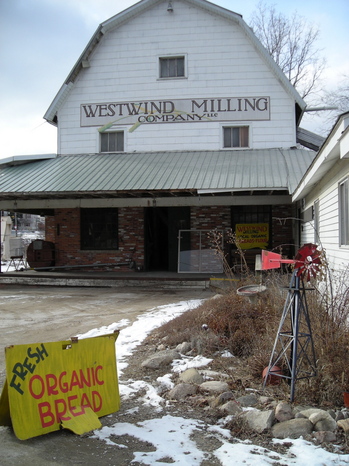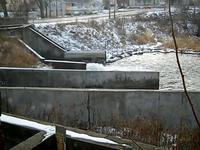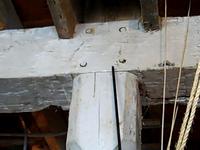Visit to Westwind Milling Company: history of a mill

The original mill is 174 years old. You can see the dam which provided the water, on the left.
Corinna Borden | Contributor
Lee and Linda Purdy purchased the 174-year-old mill in Linden nine years ago and named it Westwind Milling Company.
Lee Purdy described to me their rationale for taking on the mill, “I was an organic farmer with 160 acres of land, and it was slowly losing value. We were becoming less and less efficient. At that time we had an option to sell to raise houses - like what everyone else was doing - there was a big housing boom. But because we are hard-headed, we decided to buy an old mill and find an alternative market for our grains.”
As Purdy walked me around the mill I couldn’t help but think that the history appealed to him as well.
According to Wikipedia, the first water powered grist mills were built toward the end of the first century BC. Before that everyone was grinding grains by hand, which, given my recent run in with milling chocolate, I can say firsthand it is a time-consuming process involving a lot of elbow grease.
As Purdy explained it, “Everyone had known for hundreds of years that if you want to get nutrition out of grain, you’ve gotta break it. However you gotta do it, you have to break it. It doesn’t matter if you are feeding horses or pigs or cattle or chickens or humans.”
Breaking apart the seed coat of any grain releases the nutrition contained within the endosperm or germ (which is also where the flavor is, because fat imparts flavor).
Much like the railroads were deeded land on the side of the tracks as an incentive to expand, millers played a pivotal role in our country’s westward expansion, because wherever they were, people had an incentive to settle down and farm.

The site of the original dam is 30 yards away from the mill. The first miller ran an underground wooden flume to siphon off the water.
Corinna Borden | Contributor
The original settlement of the mill began in 1835, predating Michigan’s statehood by two years. The first thing the miller did was build a dam for the river. The dam was necessary because the miller needed a reservoir for the water to ensure a consistent water supply to turn the wheel. As Purdy said while looking over the dam, “The lake was here because the mill was here.”
Often when we think of a water wheel, we have that picture in our mind of an idyllic scene with snow on the wheel and frozen water. According to Purdy , “That is a miller's nightmare - the wheel is so out of balance, he would tear up his equipment. He would run the bearings out because the shaft would be going really fast.”
In order to prevent the wheel from freezing (a likelihood in Michigan) the miller ran a wooden flume from the dam to directly under the mill. He built the water wheel directly in the basement of the mill - thwarting the water from ever freezing thanks to geothermal heat.

The intersection of the post and beam is called a bent. Bents were constructed on the ground and pulled up when the barn was erected, often in a day.
Corinna Borden | Contributor
Having done a small bit of house renovation, I was in awe of the size of the wooden beams and joists used in the construction of the original mill. The holes for the pegs were intentionally put off by a 1/64 or 1/32 of an inch so when they drove the pegs into the hole, it would pull the joint closer together. It was important to build a solid building so the grinding of the grains would not injure the structure. Often, mills were built with two foundations to protect against damage from vibrations.
Vibrations happen when the run stone turns against the bed stone, crushing the grain between them. The miller has to sharpen the stones periodically with a chisel, called a mill bill, because hard grains can polish the granite to a mirror finish. Smooth stones are unable to grind grain. Purdy does not use a mill bill and a hammer; he has a carbide tip that he attaches to his air hammer.
“I chatter around on the surfaces to sharpen them up, or I will go through a furrow (the canal allowing the flour to leave) and make it deeper. My furrows need to be 5/32 of an inch deep at the end so there is enough room for flour to exit but not enough room for kernels of grain to come out.”
Here is Lee Purdy describing the different parts of the run stone:
After the first miller, James Murray, worked for seven years, he was deeded the mill by Martin Van Buren. He was transferred the 1,100 acres of lake that was formed when he built the dam on the river as well as 4,000 acres of abutting land (some of which became the town of Argentine). Given those statistics, one can well imagine the regard given to the miller as the provider of the means to make “one’s daily bread.”
I highly recommend contacting Lee or Linda Purdy to take a tour of Westwind Milling Company. It is totally fascinating and you can munch on a cookie as you learn!


Comments
Patti Smith
Mon, Feb 15, 2010 : 11:56 a.m.
I love this place. Their flours are awesome, but so is their corn meal. I normally am not a huge fan of cornbread and such, but it tastes so much better when I use their stuff.